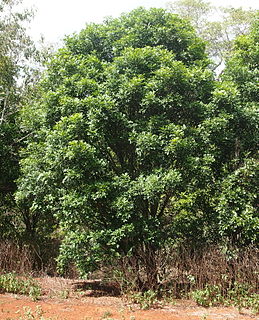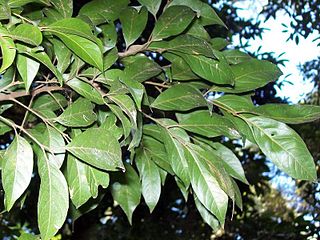
Aceraceae were recognized as a family of flowering plants also called the maple family. They contain two to four genera, depending upon the circumscription, of some 120 species of trees and shrubs. A common characteristic is that the leaves are opposite, and the fruit a schizocarp.

The quince is the sole member of the genus Cydonia in the family Rosaceae. It is a deciduous tree that bears a pome fruit, similar in appearance to a pear, and bright golden-yellow when mature. Throughout history the cooked fruit has been used as food, but the tree is also grown for its attractive pale pink blossoms and other ornamental qualities.

The Sapindaceae are a family of flowering plants in the order Sapindales known as the soapberry family. It contains 138 genera and 1858 accepted species, including maple, ackee, horse chestnut, and lychee.

Hippocastanaceae is the name given to a small group of trees and shrubs, when this group is treated as a family. Its most widespread genus is Aesculus. However, the American genus Billia and the Chinese genus Handeliodendron are also sometimes included in this family. A feature of the family is the palmate compound leaves.

The genus Aesculus, with varieties called buckeye and horse chestnut, comprises 13–19 species of flowering plants in the soapberry and lychee family, Sapindaceae. They are trees and shrubs native to the temperate Northern Hemisphere, with six species native to North America and seven to thirteen species native to Eurasia. Also, several hybrids occur. Aesculus exhibits a classical Arcto-Tertiary distribution.

Dimocarpus is a genus of about 20 species of trees or shrubs known to science, constituting part of the flowering plant family Sapindaceae. They grow naturally in tropical south and Southeast Asia, Malesia, Papuasia and Australasia, including Sri Lanka, India, the Philippines, southern China, Taiwan, Burma, Cambodia, Vietnam, Malaysia, Indonesia, New Guinea, East Timor, far north-eastern Queensland Australia.

Alectryon is a genus of about 30 species of trees and shrubs known to science, constituting part of the plant family Sapindaceae. They grow naturally across Australasia, Papuasia, Melanesia, western Polynesia, east Malesia and Southeast Asia, including across mainland Australia, especially diverse in eastern Queensland and New South Wales, the Torres Strait Islands, New Guinea, the Solomon Islands, New Caledonia, New Zealand, Vanuatu, Fiji, Samoa, Hawaii, Indonesia and the Philippines. They grow in a wide variety of natural habitats, from rainforests, gallery forests and coastal forests to arid savannas and heaths.
Hawthorn or Hawthorns may refer to:

Diploglottis is a genus of 10 species of trees known to science, constituting part of the plant family Sapindaceae. They grow naturally in rainforests and margins of adjoining humid forests in eastern Australia and New Guinea. Some species are known as native tamarind or small-leaved tamarind; they have no direct relationship with the true tamarind.

Atalaya is a genus of eighteen species of trees and shrubs of the plant family Sapindaceae. As of 2013 fourteen species grow naturally in Australia and in neighbouring New Guinea only one endemic species is known to science. Three species are known growing naturally in southern Africa, including two species endemic to South Africa and one species in South Africa, Swaziland and Mozambique.
Dimocarpus australianus also known as Australian native lychee, is a species of trees, closely related to the longan, constituting part of the plant family Sapindaceae. They grow naturally only (endemic) in Cape York Peninsula, Australia. The edible fruit tastes like lychee, sweeter than longan, and occasionally gets described as 'too sweet' in comparison by longan fanciers.
Handeliodendron bodinieri is a rare deciduous tree/shrub native to China and the only species in the monotypic genus Handeliodendron.

Cupaniopsis anacardioides, with common names tuckeroo, carrotwood, beach tamarind and green-leaved tamarind, is a species of flowering tree in the soapberry family, Sapindaceae, that is native to eastern and northern Australia. The usual habitat is littoral rainforest on sand or near estuaries. The range of natural distribution is from Seven Mile Beach, New South Wales to Queensland, northern Australia and New Guinea.

Planchonia careya is a tree species in the family Lecythidaceae. Common names include cocky apple, cockatoo apple and billygoat plum. It produces an edible fruit which tastes like quince. Indigenous Australians use the bark and leaves in medications. The bark and roots were also used as a fish poison. It should not be confused with Terminalia ferdinandiana, with which it shares some common names.

Sarcopteryx is a genus of about 12 rainforest tree species known to science, of the plant family Sapindaceae. They occur in Australia, New Guinea and the Moluccas.
Tristiropsis is a genus of about 14 flowering trees species, of the plant family Sapindaceae.

Alectryon tomentosus, commonly known as the hairy birds eye, red jacket or woolly rambutan, is a rainforest tree of the family Sapindaceae found in eastern Australia. The specific epithet tomentosus refers to the hairy leaves and hairy young shoots.

The Brunswick Heads Nature Reserve is a protected nature reserve located in the Northern Rivers region of New South Wales, Australia. The 221-hectare (550-acre) reserve is situated near Brunswick Heads and contains an intact segment of littoral rainforest.

Mischarytera is a genus of rainforest trees, constituting part of the plant family Sapindaceae. Four species are known to science as of December 2013, found growing naturally in eastern Queensland, Australia, and in New Guinea. Formerly until 1995, they had names within the genus Arytera, subgenus Mischarytera.
















